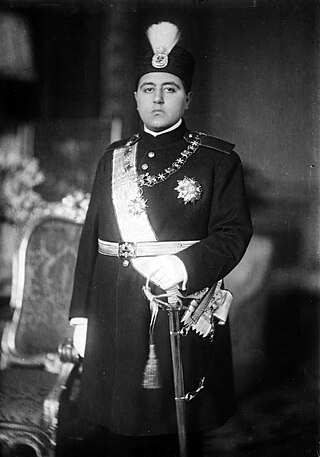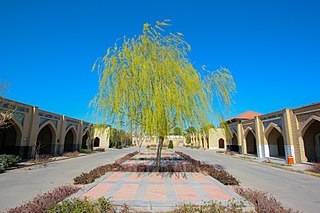
Ahmad Shah Qajar was Shah of Persia (Iran) from 16 July 1909 to 15 December 1925, and the last ruling member of the Qajar dynasty.

Mohammad Ali Shah Qajar Shah of Iran from 8 January 1907 to 16 July 1909. He was the sixth shah of the Qajar dynasty.

Fath-Ali Shah Qajar was the second Shah (king) of Qajar Iran. He reigned from 17 June 1797 until his death on 24 October 1834. His reign saw the irrevocable ceding of Iran's northern territories in the Caucasus, comprising what is nowadays Georgia, Dagestan, Azerbaijan, and Armenia, to the Russian Empire following the Russo-Persian Wars of 1804–1813 and 1826–1828 and the resulting treaties of Gulistan and Turkmenchay. Historian Joseph M. Upton says that he "is famous among Iranians for three things: his exceptionally long beard, his wasp-like waist, and his progeny."

Mozaffar ad-Din Shah Qajar, was the fifth Qajar shah (king) of Iran, reigning from 1896 until his death in 1907. He is often credited with the creation of the Persian Constitution of 1906, which he approved of as one of his final actions as shah.

Behesht-e Zahra is the largest cemetery in Iran. Located in the southern part of metropolitan Tehran, it is connected to the city by Tehran Metro Line 1.

The Shāh Abdol-Azīm Shrine, also known as Shabdolazim, located in Rey, Iran, contains the tomb of ‘Abdul ‘Adhīm ibn ‘Abdillāh al-Hasanī. Shah Abdol Azim was a fifth generation descendant of Hasan ibn ‘Alī and a companion of Muhammad al-Taqī. He was entombed here after his death in the 9th century.

Dār ul-Funun is the oldest Western-style institute of higher education in Iran, established by the royal vizier to Nasereddin Shah in 1851.

Reza-Qoli Khan Hedayat was an Iranian literary historian, administrator, and poet in 19th-century Qajar Iran.

Abdol-Hossein Farman Farma was a prominent Iranian prince in the Qajar dynasty and one most influential Iranian politicians in the Qajar era. Born in Tehran to Prince Nosrat Dowleh Firouz in 1857, he was the 16th grandson of the Qajar crown prince Abbas Mirza. He fathered 26 sons and 13 daughters by 8 wives. He lived to see four sons of his first wife die within his lifetime.

Mohsen Sadr was a judge and politician, the prime minister of Iran and the president of the Senate of Iran. During his government, Iran became one of the founding states of the United Nations by signing the Charter of the United Nations.

The Shrine of Fatima Masumeh is located in Qom, which is considered by Twelver Shia Muslims to be the second most sacred city in Iran after Mashhad.

Prince Firouz Nosrat-ed-Dowleh III, GCMG (1889–1937) was the eldest son of Prince Abdol-Hossein Farmanfarma and Princess Ezzat-ed-Dowleh Qajar. He was born in 1889 and died in April 1937. He was the grandson of his namesake, Nosrat Dowleh Firouz Mirza, and of Mozzafar-al-Din Shah Qajar through his mother, Princess Ezzat-Dowleh.

Samad Khan Momtaz os-Saltaneh, or Momtaz ol Saltaneh was an Iranian diplomat of the Qajar and Pahlavi dynasty era.

Kamran Mirza was a Persian Prince of Qajar dynasty and third surviving son of Nasser al-Din Shah. He was the brother of Mass'oud Mirza Zell-e Soltan and Mozzafar al-Din Shah. Kamran Mirza also served as Iran's Commander-in-Chief, appointed in 1868 for the first time, and minister of war from 1880 to 1896 and from 1906 to 1907.
The surname Hedayat is used by different families of Middle East origins. In Iran when referring to that family name without further specification, it mostly refers to one prominent family originating from Mazanderan in Northern Iran. Notable people from this family include:

Imamzadeh Abdollah is a cemetery and one of many imamzadeh shrines in Iran. It is located in Tehran's southern Ray district.
The following lists events that have happened in 1907 in the Qajar dynasty.

Anoushirvan (Shir) Khan Qajar Qovanlou 'Eyn ol-Molk' 'Etezad od-Doleh' was an Iranian aristocrat, general and courtier.

















